Beginners Guides
What Are The Tiny Gnats In My House

Have you ever found yourself relaxing in your living room, simply enjoying your own company, when out of nowhere a bunch of small gnats start buzzing around you? It’s an irritating and bothersome situation, something numerous homeowners have unfortunately experienced.
But what exactly are these pesky insects, and why do they seem to have taken up residence in your house?
Well, let me shed some light on the subject. Gnats are small flying insects that belong to the family of flies. They are commonly found in homes and can be a real nuisance. There are several types of gnats that may infest your house, including fruit flies, fungus gnats, and drain flies.
The causes of gnat infestations can vary, but they are often attracted to areas with moisture and decaying organic matter. This could include overripe fruits, damp soil, or even clogged drains. However, there are steps you can take to prevent and eliminate these tiny pests from your home.
In this article, I will provide you with some valuable information on the types of gnats found in homes, common causes of infestations, prevention tips, and natural remedies to get rid of them. I will also discuss chemical solutions and how to identify and eliminate gnat breeding sites.
Additionally, I will touch on the health concerns related to gnats and when it may be necessary to seek professional help for persistent infestations.
So, if you’re tired of dealing with these tiny gnats in your house, keep reading to find out how to regain control of your home and bid farewell to these unwelcome guests.
Key Takeaways
- Gnats are attracted to moisture and decaying organic matter, so it’s important to keep the house clean and dry to prevent infestations.
- Proper plant care, including allowing soil to dry between waterings, can help prevent gnat infestations caused by indoor plants.
- Natural gnat repellents such as citronella candles, essential oils, and vinegar traps can be effective in controlling and eliminating gnats.
- If gnat infestations persist or are severe, it is recommended to seek professional pest control services for accurate identification and tailored solutions.
Types of Gnats Found in Homes
You’ll often find those pesky little gnats buzzing around your house, from the fruit flies that hover near your overripe bananas to the fungus gnats flitting around your damp houseplants.
Gnats in food can be a frustrating problem, as they contaminate your kitchen and can even make you sick. Fruit flies are attracted to rotting fruits and vegetables, while fungus gnats thrive in moist soil.
To prevent gnat infestations, it’s crucial to store your produce properly and dispose of any spoiled items promptly. Keep your kitchen clean and free of crumbs, and regularly empty your garbage bins. Additionally, ensure that your houseplants are not overwatered and that excess moisture is drained away.
By eliminating their preferred breeding grounds, you can greatly reduce the number of gnats in your home. It’s important to take these preventative measures because gnat infestations can be caused by common factors such as poor sanitation and excessive moisture.
Common Causes of Gnat Infestations
In my experience, the common causes of gnat infestations in homes often revolve around three key points:
-
Overripe fruits and vegetables attract gnats due to the sweet scent emitted by rotting produce. This makes overripe fruits and vegetables a prime breeding ground for these tiny pests.
-
Moisture and damp areas provide ideal conditions for gnats to thrive. They are attracted to moist and damp environments, such as leaky faucets or areas with poor ventilation.
-
Indoor plants can also contribute to gnat infestations. The damp soil in indoor plants provides an ideal habitat for gnat larvae to grow and mature.
Overripe fruits and vegetables
To get rid of those tiny gnats in your house, check for any overripe fruits or vegetables. Gnat infestations can often be prevented by properly disposing of spoiled produce. Signs of overripe produce include a soft and mushy texture, a strong and unpleasant odor, and the presence of mold or fungi.
If you notice any of these signs, it’s important to remove the affected fruits or vegetables immediately. Place them in a sealed bag and dispose of them in an outdoor trash bin to prevent further attraction of gnats.
Once you’ve addressed the issue of overripe produce, it’s important to move on to the next step: moisture and damp areas.
Moisture and damp areas
One interesting statistic to consider is that damp areas in a home can hold up to 4 gallons of water, creating an ideal breeding ground for pests.
Mold and mildew thrive in these moist environments, providing a food source for tiny gnats. Additionally, plumbing leaks can contribute to the moisture problem, further attracting these pests.
It’s important to address any plumbing issues promptly to prevent the buildup of excess moisture. Regularly inspecting and repairing leaks can help eliminate the damp conditions that gnats find favorable.
Now, let’s move on to the next section about indoor plants and how they can also contribute to the presence of these tiny gnats in your house.
Indoor plants
Indoor plants can transform your home into a lush oasis, but did you know that they could also inadvertently invite unwanted pests? When it comes to indoor gardening, proper plant care is essential to prevent infestations of tiny gnats. These pests, commonly known as fungus gnats, thrive in moist environments, making indoor plants an ideal breeding ground for them. To effectively combat this issue, it is crucial to understand the factors that attract gnats to plants. Table 1 below outlines some key points to consider for indoor plant care:
| Factors Attracting Gnats to Plants | |||
|---|---|---|---|
| Overwatering | Damp Soil | Lack of Air Circulation | Decomposing Organic Matter |
By practicing good plant care techniques, such as allowing soil to dry between waterings and providing adequate airflow, you can minimize the risk of gnat infestations. Now that we understand the importance of indoor plant care, let’s explore prevention tips to keep gnats away.
Prevention Tips to Keep Gnats Away
Keeping your house clean and removing any potential food sources can help ward off those pesky gnats, ensuring that your home remains a gnat-free oasis. To prevent gnats from entering your house, make sure all windows and doors are properly sealed to eliminate any entry points. Additionally, repair any cracks or holes in walls or floors to further deter these tiny pests from finding their way in.
Another effective way to keep gnats away is by using natural gnat repellents. Citronella candles, essential oils like eucalyptus or lavender, and vinegar traps are all great options. Citronella candles emit a scent that repels gnats, while essential oils can be diluted with water and sprayed around the house. Vinegar traps can be made by filling a jar with apple cider vinegar and covering it with plastic wrap, poking small holes in the wrap to attract and trap gnats.
By taking these preventative measures and utilizing natural gnat repellents, you can ensure a gnat-free environment in your home. Transitioning into the next section about natural remedies to get rid of gnats, let’s explore some easy and effective ways to eliminate these pesky insects.
Natural Remedies to Get Rid of Gnats
To create a gnat-free environment, you can easily try out these natural remedies that’ll have you enjoying your home without these pesky insects.
There are several natural gnat repellents that you can use to keep these bugs at bay. One effective option is using essential oils such as peppermint, lemongrass, or lavender. Simply mix a few drops of the oil with water in a spray bottle and spray it around areas where gnats are commonly found.
Another natural repellent is apple cider vinegar. Fill a small bowl with apple cider vinegar and a few drops of dish soap. The gnats will be attracted to the vinegar and get trapped in the soapy solution.
In addition to repellents, homemade gnat traps can be an effective way to eliminate these annoying pests. One popular trap is the vinegar trap. Fill a jar with apple cider vinegar and cover it with plastic wrap, securing it with a rubber band. Poke a few small holes in the plastic wrap. The gnats will be attracted to the vinegar and get trapped inside the jar.
By using these natural remedies and traps, you can effectively get rid of gnats in your home without resorting to harsh chemicals. However, if these methods don’t work, you may need to consider chemical solutions for gnat control.
Chemical Solutions for Gnat Control
When it comes to dealing with gnats, there are several chemical solutions available.
Insecticides can be used to effectively eliminate gnats by directly targeting and killing them.
Gnat traps and baits are also effective in attracting and trapping gnats, reducing their population.
Finally, for severe infestations or persistent gnat problems, professional pest control services can provide expert assistance in eradicating these pests.
Insecticides
Spray insecticides to rid your house of those pesky little gnats, and watch them disappear like magic.
When using insecticides, it’s important to prioritize safety. Always read and follow the instructions provided by the manufacturer. Wear protective clothing and make sure the area is well-ventilated.
Additionally, consider alternative insect control methods to minimize exposure to chemicals. While insecticides can effectively eliminate gnats, there are other options available. For instance, you can try using gnat traps and baits, which are designed to lure and capture these annoying pests. These traps and baits can be placed strategically around your house to attract and trap gnats.
By utilizing a combination of insecticides and alternative methods like traps and baits, you can effectively eliminate gnats from your home.
Gnat traps and baits
By employing a combination of insecticides and alternative methods like traps and baits, one can effectively eliminate these irksome pests known as gnats from their dwelling. Gnats have a short life cycle, typically lasting around 4 weeks. Understanding their life cycle can help in targeting them effectively. Homemade gnat traps are a popular and cost-effective way to get rid of these tiny insects. One simple trap involves a mixture of apple cider vinegar and dish soap, which attracts gnats and traps them when they come into contact with the solution. Another effective trap is a bowl filled with red wine and covered with plastic wrap, with small holes poked into it. Gnats are lured by the scent of the wine and get trapped inside the bowl. These homemade traps can significantly reduce the gnat population in your house. However, for severe infestations, professional pest control services may be necessary to completely eradicate the gnats.
Professional pest control services
To completely eradicate the gnat infestation, you might consider seeking professional pest control services, as they possess the expertise and resources to effectively eliminate these bothersome pests from your residence. Here are three reasons why professional pest control services are worth considering:
-
Natural gnat repellents: Pest control professionals have access to natural repellents that are safe for you and your family, but highly effective in repelling gnats.
-
DIY gnat control methods: Professionals can provide you with valuable advice on DIY gnat control methods, such as using vinegar traps or essential oils, to complement their treatment.
-
Expertise and resources: Pest control experts have the knowledge and tools necessary to identify the root cause of the gnat infestation and implement targeted solutions.
By utilizing professional pest control services, you can ensure a comprehensive approach to gnat control.
In the next section, we’ll explore how to identify and eliminate gnat breeding sites, a crucial step in eradicating these pests from your home.
Identifying and Eliminating Gnat Breeding Sites
Eliminating those pesky gnats in your house starts with identifying and getting rid of their breeding sites. Gnats, also known as fruit flies or vinegar flies, have a short life cycle of about 10 days. Understanding their breeding habits is crucial in effectively eliminating them. Gnats prefer to lay their eggs in moist organic matter, such as overripe fruits, vegetables, and damp soil. By eliminating these breeding sites, you can significantly reduce the gnat population in your home.
To help you identify and eliminate gnat breeding sites, refer to the table below:
| Breeding Site | Description | Elimination |
|---|---|---|
| Overripe fruits and vegetables | Check for any spoiled produce in your kitchen and dispose of them properly. | Regularly inspect and discard any overripe fruits or vegetables. |
| Standing water | Gnats are attracted to stagnant water. Remove any standing water sources, such as pet bowls and vases. | Change water regularly and ensure proper drainage. |
| Damp soil | Gnats thrive in damp soil. Allow the top layer of soil to dry out between waterings. | Adjust watering frequency and improve soil drainage. |
By following these steps, you can significantly reduce the number of gnats breeding in your house. Next, we will discuss how to deal with gnats outdoors without using harmful chemicals.
Dealing with Gnats Outdoors
If you’re tired of dealing with those pesky outdoor gnats, here’s a simple solution that doesn’t involve harmful chemicals: create a DIY gnat trap using a mixture of apple cider vinegar and dish soap in a shallow bowl.
For example, imagine you’re hosting a backyard barbecue and want to keep the gnats away from the food and guests.
To effectively deal with gnats outdoors, consider the following natural gnat repellents:
- Plant herbs like basil, lavender, or mint in your outdoor spaces. Gnats are naturally repelled by their strong scents.
- Use citronella candles or torches when spending time outside. The scent of citronella helps keep gnats at bay.
- Place fans strategically around your outdoor areas. The steady breeze makes it difficult for gnats to fly and bother you.
- Keep your outdoor spaces clean and free of standing water. Gnats are attracted to moisture, so eliminate any potential breeding sites.
- Consider using gnat traps or sticky fly paper to capture and eliminate gnats in your outdoor areas.
By implementing these natural gnat repellents, you can enjoy your outdoor activities without the nuisance of gnats. However, it’s important to be aware of gnat-related health concerns.
Gnat-Related Health Concerns
When it comes to gnat-related health concerns, there are three key points to consider:
-
Allergic reactions can occur in some individuals who are sensitive to gnat bites, resulting in symptoms such as itching, redness, and swelling.
-
Gnats have the potential to transmit diseases such as West Nile virus and encephalitis, making them a potential health risk.
-
Gnat bites can be quite irritating, causing discomfort and sometimes leading to secondary infections if not properly treated.
Allergic reactions
To truly understand the frustration of dealing with tiny gnats in your house, you must be aware of the potential allergic reactions they can trigger. These reactions vary from person to person, but commonly include symptoms such as itching, redness, and swelling of the skin.
In more severe cases, individuals may experience difficulty breathing, wheezing, and even anaphylaxis. If you suspect you’re allergic to gnats, it’s important to seek medical advice. Allergies can be managed with medication, such as antihistamines, which help alleviate symptoms and reduce the body’s immune response. Treatment may also involve the use of topical creams or ointments to soothe irritated skin.
Remember, being proactive in addressing allergies is crucial to maintaining a comfortable and healthy living environment.
Now, let’s delve into the next section about disease transmission.
Disease transmission
Disease transmission can occur when gnats come into contact with contaminated surfaces and then land on food or skin. These tiny insects can carry and spread various diseases, making it crucial to understand the methods of transmission and take steps for disease prevention. To better illustrate this, I have created a table below outlining some common transmission methods and the diseases associated with them.
| Transmission Method | Associated Diseases |
|---|---|
| Contaminated surfaces | Salmonellosis, E.coli infection |
| Contact with skin | Leishmaniasis, Filariasis |
| Ingestion of food | Giardiasis, Cryptosporidiosis |
By being aware of these transmission methods, we can take necessary precautions such as keeping surfaces clean, wearing protective clothing, and practicing proper food hygiene. Understanding the potential risks associated with gnat-borne diseases is essential for effective disease prevention. Moving forward, let’s explore the topic of gnat bites and irritation.
Gnat bites and irritation
Gnat bites can be incredibly irritating, causing redness, itching, and discomfort. Understanding gnat behavior is essential to prevent these bites and minimize irritation.
Gnats are attracted to moisture and organic matter, making kitchens and bathrooms common areas for infestations. To prevent gnats, it’s crucial to keep these areas clean and dry. Repairing leaky faucets, ensuring proper drainage, and regularly emptying trash bins can help eliminate their breeding grounds. Additionally, sealing cracks and gaps in windows and doors can prevent the entry of gnats into the house. Using screens on windows and doors can also be effective.
If gnat infestations persist despite these prevention methods, seeking professional help may be necessary. Transitioning into the next section, seeking professional help is recommended when dealing with persistent gnat infestations.
Seeking Professional Help for Persistent Gnat Infestations
When you’re at your wit’s end with those pesky little critters, it’s time to call in the cavalry and let the experts work their magic, just like summoning a squadron of bug-busting superheroes. Seeking professional advice is essential when dealing with persistent gnat infestations. These knowledgeable individuals can provide valuable insights and recommend long-term gnat control options.
Here are five reasons why consulting professionals is the way to go:
-
Expertise: Pest control professionals have extensive knowledge and experience in dealing with gnat infestations. They can accurately identify the species of gnats, determine the root cause of the problem, and devise effective control strategies.
-
Customized Solutions: Professionals understand that every gnat infestation is unique. They will tailor their approach based on the severity of the infestation, the specific type of gnats involved, and the environment in which they are breeding.
-
Integrated Pest Management (IPM): Pest control experts use a holistic approach called IPM. This method focuses on long-term prevention by addressing the underlying causes of the infestation, rather than simply treating the symptoms.
-
Safe and Effective Treatments: Professionals have access to specialized tools and insecticides that are both safe and effective in eliminating gnats. They know how to apply these treatments correctly, minimizing risks to humans, pets, and the environment.
-
Long-Term Solutions: Instead of providing temporary relief, professionals aim to solve the gnat problem for the long haul. They will provide recommendations for preventive measures and ongoing maintenance to ensure that the infestation does not reoccur.
By seeking professional help, you can gain peace of mind knowing that your gnat infestation is being handled by experts who will implement effective and sustainable solutions.
Frequently Asked Questions
How long do gnats typically live?
Gnats typically live for about 7-10 days, but their lifespan can be influenced by various factors. These include temperature, humidity, availability of food, and breeding conditions.
Can gnats cause damage to my home or belongings?
Gnats can cause damage to indoor plants but not to homes or belongings. To get rid of gnats in the house, try natural remedies like apple cider vinegar traps, flypaper, or removing overripe fruit.
Are gnats attracted to certain colors or scents?
Gnats can be attracted to certain colors and scents, but there are natural remedies to repel them. To prevent gnats from entering your home, keep doors and windows closed, use screens, and remove standing water.
Can gnats bite humans or pets?
Yes, gnats can bite both humans and pets. While their bites are generally harmless, they can cause itching and irritation. Gnats are not known to transmit diseases. Prevention and control of gnat infestations involve eliminating breeding sites and using insecticides if necessary.
How do gnats reproduce and multiply in such large numbers?
Gnats reproduce and multiply rapidly due to their short life cycle and ability to lay hundreds of eggs. To control infestations, eliminate breeding grounds by keeping your house clean, removing standing water, and using insecticides if necessary.
Conclusion
Well, after learning all about these pesky little gnats that have invaded my house, I can confidently say that I’m absolutely thrilled to have them as my new roommates. Who wouldn’t want these tiny flying insects buzzing around their face all day long?
The constant annoyance and frustration they bring to my life is truly a gift. I’m so grateful for their presence, and I can’t wait to continue battling with them day in and day out.
Life just wouldn’t be the same without these delightful creatures.
Hi, I’m Emma. I’m the Editor in Chief of Tiny House 43, a blog all about tiny houses. While tree houses are often associated with childhood, they can be the perfect adult retreat. They offer a cozy space to relax and unwind, surrounded by nature. And since they’re typically built on stilts or raised platforms, they offer stunning views that traditional homes simply can’t match. If you’re looking for a unique and romantic getaway, a tree house tiny house might just be the perfect option.
Beginners Guides
How Do I Finance a Tiny House

I have always desired to own a small, comfortable home, but typical financing solutions appeared unattainable. That’s when I found out about the concept of tiny houses. These efficient, eco-friendly residences provide a budget-friendly option to conventional homes.
But how do I finance a tiny house? In this article, I’ll guide you through the various financing options and share practical tips for saving and budgeting. Whether you’re a minimalist enthusiast or simply looking to downsize, this article is here to help you make your tiny house dreams a reality.
Key Takeaways
- Financing options for tiny houses include personal loans, RV loans, and crowdfunding platforms.
- Traditional financing options such as bank loans and personal loans from banks or online lenders are available for tiny house financing.
- Alternative financing options like crowdfunding and personal loans can be explored, but they have their own pros and cons.
- Saving and budgeting for a tiny house is important, and options like obtaining a loan specifically designed for tiny house financing or exploring crowdfunding platforms can be considered.
Understanding the Cost of a Tiny House
I can’t believe how much it costs to build a tiny house. Understanding the financing process and the factors affecting the cost of a tiny house is crucial before embarking on this journey.
Firstly, let’s talk about the financing process. Many people choose to finance their tiny houses through personal loans, RV loans, or even crowdfunding platforms. It’s important to research and compare interest rates and terms to find the best option for your financial situation.
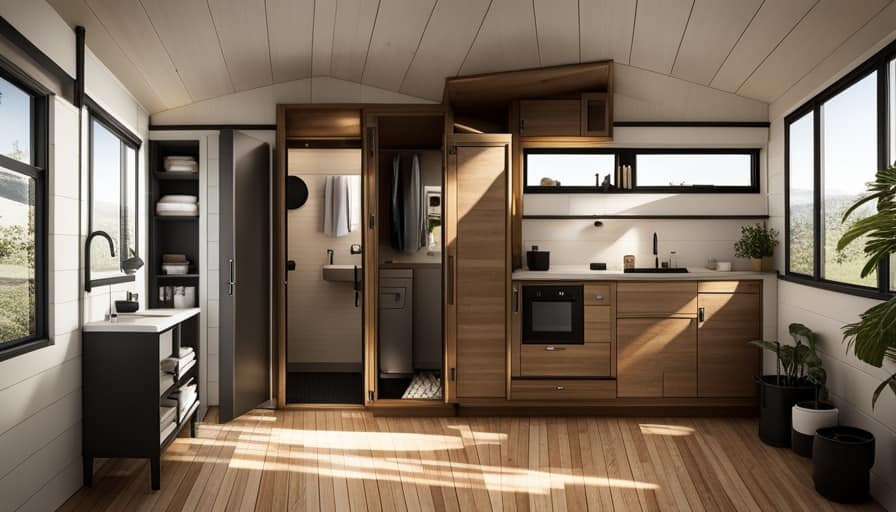
Now, let’s discuss the factors that affect the cost of a tiny house. Size, materials, and customization are the main factors. The larger the size, the more materials and labor will be required, thus increasing the cost. Additionally, using high-quality and sustainable materials can also raise the price. Lastly, customization, such as unique designs or added features, will add to the overall cost.
Exploring Traditional Financing Options
When exploring financing options for a tiny house, it’s important to consider traditional routes such as bank loans or credit unions. These options can provide the necessary funds to purchase or build your dream tiny house. Here are some key points to keep in mind when considering traditional financing options:
-
Traditional bank loans: Many banks offer loans specifically designed for home construction or purchases, which can be used for a tiny house.
-
Personal loans: If you don’t qualify for a traditional bank loan, personal loans from banks or online lenders can be a viable alternative.

-
Interest rates: Traditional financing options may offer competitive interest rates, depending on your creditworthiness and other factors.
-
Repayment terms: It’s important to carefully review the repayment terms of any loan you consider, including the length of the loan and monthly payment amounts.
-
Eligibility requirements: Different lenders have different eligibility criteria, so it’s important to research and compare options to find the best fit for your needs.
Exploring traditional financing options can provide a solid foundation for financing your tiny house.

However, there are also alternative financing options worth considering, which will be explored in the next section.
Exploring Alternative Financing Options
One option to consider when exploring alternative financing options for a tiny house is crowdfunding. Crowdfunding is a method of raising funds by pooling small amounts of money from a large number of people. It can be a viable option for financing a tiny house as it allows individuals to contribute towards the project. Another alternative financing option is personal loans. Personal loans are loans that are not secured by any collateral, such as a house or car. They can be used to finance a variety of expenses, including the construction or purchase of a tiny house. When considering personal loans, it is important to shop around for the best interest rates and terms. Below is a table comparing crowdfunding and personal loans as alternative financing options for a tiny house:
| Financing Option | Pros | Cons |
|---|---|---|
| Crowdfunding | – Can raise funds from others | – No guarantee of reaching goal |
| Personal Loans | – Can be used for any purpose | – May require good credit score |
Both crowdfunding and personal loans can provide alternative financing options for a tiny house. It is important to carefully consider the pros and cons of each option before making a decision.
Tips for Saving and Budgeting for a Tiny House
Saving and budgeting for a tiny house involves prioritizing expenses and finding ways to cut costs. Here are some practical tips to help you save and budget effectively:

- Create a detailed budget: Start by listing all your expenses and income to determine how much you can allocate towards your tiny house.
- Cut unnecessary expenses: Identify areas where you can reduce spending, such as eating out less or canceling unused subscriptions.
- Save consistently: Set aside a certain amount of money each month specifically for your tiny house fund.
- Consider a tiny house loan: Research options for obtaining a loan specifically designed for tiny house financing.
- Explore crowdfunding options: Crowdfunding platforms can help you raise funds for your tiny house project by reaching out to a wider network of supporters.
By implementing these tips, you can make steady progress towards your goal of owning a tiny house.
Now, let’s explore some resources for grants and financial assistance to further support your journey.
Resources for Grants and Financial Assistance
I can explore various resources for grants and financial assistance to help me finance my tiny house. Grants are a great option to consider, as they provide funding that doesn’t need to be repaid.
There are several organizations and programs that offer grants specifically for individuals looking to build or purchase a tiny house. One such resource is the Tiny House Fund, which provides grants to low-income individuals and families for the construction of tiny houses.

Another option is the Housing Assistance Council, which offers grants to organizations that provide housing assistance to low-income individuals.
It’s important to note that grants availability may vary depending on location and eligibility criteria. Therefore, it’s crucial to research and identify grants that align with your specific needs and circumstances.
Frequently Asked Questions
Can I Use a Personal Loan to Finance a Tiny House?
Yes, you can use a personal loan to finance a tiny house. It’s one of the alternative financing options available. However, make sure to research interest rates and terms to find the best option for you.
Are There Any Specific Qualifications I Need to Meet in Order to Obtain a Traditional Mortgage for a Tiny House?
To obtain a traditional mortgage for a tiny house, you need to meet certain qualifying criteria. The application process requires providing necessary documentation, such as income verification and credit history.

Are There Any Tax Benefits or Incentives Available for Financing a Tiny House?
Tax benefits and incentives can be available when financing a tiny house. It’s important to research and consult with a tax professional to understand the specific benefits that may apply to your situation.
What Are the Advantages and Disadvantages of Using Alternative Financing Options for a Tiny House?
Using alternative financing options for a tiny house has advantages, such as flexibility and lower interest rates, but also disadvantages, like stricter eligibility criteria. It’s important to weigh the pros and cons before deciding.
Are There Any Specific Tips or Strategies for Saving and Budgeting for a Tiny House That Differ From Traditional Homeownership?
When it comes to saving and budgeting for a tiny house, there are some specific tips and strategies that differ from traditional homeownership. Some budgeting strategies include cutting expenses, tracking spending, and setting realistic goals. Additionally, saving techniques like automating savings and finding ways to earn extra income can help you reach your financial goals faster.
Conclusion
In conclusion, financing a tiny house may seem daunting, but with careful planning and research, it can be achievable.

By understanding the costs involved, exploring traditional and alternative financing options, and implementing smart saving and budgeting strategies, you can make your dream of owning a tiny house a reality.
Remember, there are also resources available such as grants and financial assistance programs that can provide additional support.
So don’t let financial barriers hold you back, start exploring your options today and embark on your tiny house journey.
I’m Theodore, and I love tiny houses. In fact, I’m the author of Tiny House 43, a book about tiny houses that are also tree houses. I think they’re magical places where imaginations can run wild and adventures are just waiting to happen.
While tree houses are often associated with childhood, they can be the perfect adult retreat. They offer a cozy space to relax and unwind, surrounded by nature. And since they’re typically built on stilts or raised platforms, they offer stunning views that traditional homes simply can’t match.
If you’re looking for a unique and romantic getaway, a tree house tiny house might just be the perfect option.
Beginners Guides
How Do I Draw a Tiny House
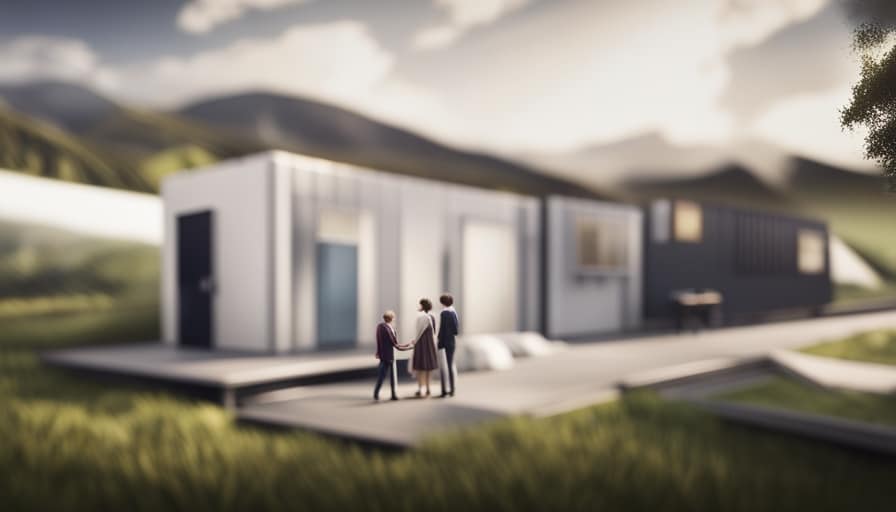
As a future architect, I am constantly captivated by the complexities involved in sketching a small house. It is often said that the beauty lies in the details, and this miniature masterpiece truly exemplifies that sentiment.
In this article, I will guide you through the process of creating a detailed and precise drawing of a tiny house. From understanding the basics of design to adding those finishing touches, you’ll discover how to bring your vision to life on paper.
Let’s dive in and unlock the secrets of drawing a tiny house!
Key Takeaways
- Tiny house design principles prioritize maximizing space in a small footprint and utilizing multi-functional spaces.
- Accurate measurements and choosing the appropriate scale are crucial for a precise and realistic representation.
- Sketching out the layout and floor plan should consider unique storage solutions, placement of windows for natural light, and attention to detail and proportions.
- Adding detail to tiny house elevations can be done by selecting the perfect color palette, incorporating unique architectural elements, and considering light, neutral tones or bold, vibrant colors.
Understanding the Basics of Tiny House Design
As I begin to draw a tiny house, I must first understand the basics of its design. Tiny house design principles are centered around maximizing space in a small footprint. When designing a tiny house, it’s crucial to carefully consider every inch of the layout.

One key principle is to prioritize multi-functional spaces. Each area should serve multiple purposes, such as a living room that can also convert into a bedroom. Storage is another important aspect, with clever solutions like built-in cabinets and hidden compartments. Additionally, utilizing vertical space through lofted areas or tall shelving can help maximize storage and living areas.
Choosing the Right Scale for Your Tiny House Drawing
I should consider the size and dimensions of my tiny house when choosing the right scale for my drawing. Accurate measurements are crucial in creating a precise and realistic representation of my tiny house. By using the correct scale, I can ensure that every element of the design is accurately depicted.
Exploring different design elements for my tiny house scale drawings allows me to experiment with various layouts and configurations. This not only helps me visualize the final result, but also enables me to make informed decisions regarding the placement of furniture, appliances, and other features.
Once I’ve determined the appropriate scale, I can confidently move on to sketching out the layout and floor plan, bringing my tiny house design to life.

Sketching Out the Layout and Floor Plan
Once I’ve chosen the right scale for my tiny house drawing, it’s important to start sketching out the layout and floor plan.
To ensure an efficient use of space, I’ll incorporate unique storage solutions. This can include built-in shelving, hidden compartments, and multi-functional furniture.
Additionally, I’ll carefully consider the placement of windows for optimal natural light. This won’t only enhance the overall ambiance of the tiny house but also reduce the need for artificial lighting during the day.
By strategically positioning windows in areas where sunlight is abundant, I can create a bright and airy atmosphere.

It’s crucial to prioritize both functionality and aesthetics when sketching out the layout and floor plan of a tiny house.
Adding Detail to Your Tiny House Elevations
While adding detail to my tiny house elevations, I’ll focus on incorporating architectural elements that enhance the overall design and character of the house.
One important aspect to consider is selecting the perfect color palette for your tiny house design. The colors you choose can greatly impact the visual appeal and atmosphere of your tiny home. Consider using light, neutral tones to create a spacious and airy feel, or bold and vibrant colors to add a pop of personality.
In addition to color, incorporating unique architectural elements into your tiny house elevation can make it stand out. Whether it’s a charming bay window, a decorative trim, or an interesting roofline, these elements can add visual interest and character to your tiny home.

By carefully selecting colors and incorporating unique architectural elements, you can create a tiny house elevation that’s both visually appealing and reflective of your personal style.
Now, let’s move on to finalizing your tiny house drawing with finishing touches.
Finalizing Your Tiny House Drawing With Finishing Touches
Adding decorative details and selecting the right materials are key steps in finalizing your tiny house drawing with finishing touches. To ensure your tiny house design truly stands out, consider the following:
-
Selecting the perfect color palette: Choose colors that reflect your personal style and create an inviting atmosphere. Consider using light and neutral tones to make the space feel larger, or vibrant shades to add a pop of energy.
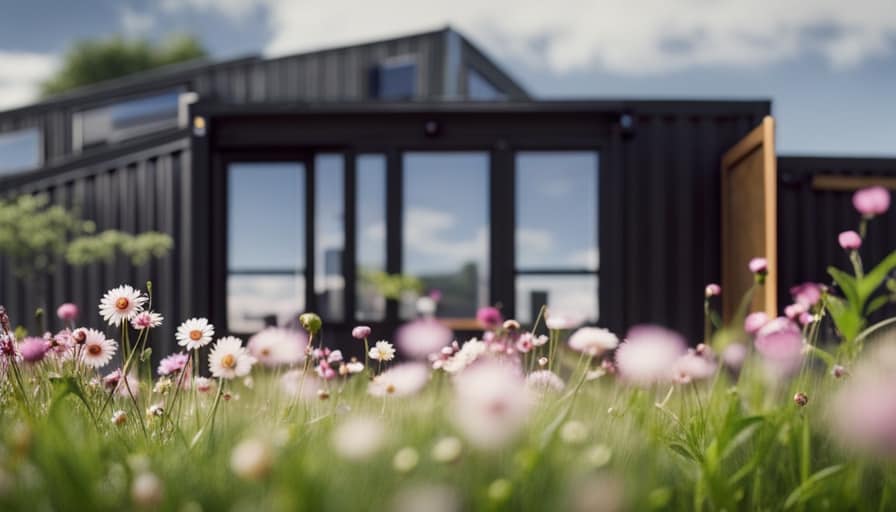
-
Incorporating sustainable and eco-friendly elements: Make your tiny house environmentally friendly by incorporating features such as solar panels, rainwater harvesting systems, and energy-efficient appliances. Use recycled or reclaimed materials whenever possible to reduce waste and minimize your environmental footprint.
-
Adding unique architectural details: Consider incorporating unique architectural elements like exposed beams, arched windows, or a charming front porch to give your tiny house character and charm.
-
Enhancing with landscaping: Don’t forget about the exterior! Enhance your tiny house design with landscaping elements such as flower beds, shrubs, or a small vegetable garden. This will add curb appeal and create a welcoming outdoor space.
Frequently Asked Questions
What Are Some Common Challenges or Obstacles to Consider When Designing a Tiny House?
When designing a tiny house, it is important to consider common challenges and obstacles such as space optimization and design challenges. These factors require precise planning and attention to detail to ensure optimal functionality and livability.

Can I Use Software or Online Tools to Create My Tiny House Drawing?
Yes, you can use software or online tools to create your tiny house drawing. It is best to follow these practices for creating detailed designs: utilize accurate measurements, incorporate necessary features, and ensure proper scaling for a realistic representation.
Are There Any Specific Building Codes or Regulations That I Should Be Aware of When Designing a Tiny House?
When designing a tiny house, it is important to be aware of building code requirements and zoning restrictions. These regulations ensure the safety and legality of your structure, so it’s crucial to familiarize yourself with them before starting your design process.
How Do I Incorporate Sustainable and Eco-Friendly Features Into My Tiny House Design?
To incorporate sustainable and eco-friendly features into my tiny house design, I can use eco-friendly materials like reclaimed wood and recycled insulation. Additionally, I can install energy-efficient systems such as solar panels and a rainwater harvesting system.
Are There Any Recommended Resources or Communities for Further Inspiration and Support in Designing a Tiny House?
There are recommended resources and communities for inspiration and support in tiny house design. Check out tiny house design competitions and online forums for enthusiasts. They provide valuable insights and connections for your project.

Conclusion
In conclusion, drawing a tiny house requires understanding the basics of design, choosing the right scale, and sketching out the layout and floor plan.
By adding detail to the elevations and finalizing the drawing with finishing touches, you can create a precise and detailed representation of your dream tiny home.
Just like a skilled architect carefully crafts a blueprint, your tiny house drawing will serve as the foundation for turning your vision into reality.
I’m Theodore, and I love tiny houses. In fact, I’m the author of Tiny House 43, a book about tiny houses that are also tree houses. I think they’re magical places where imaginations can run wild and adventures are just waiting to happen.
While tree houses are often associated with childhood, they can be the perfect adult retreat. They offer a cozy space to relax and unwind, surrounded by nature. And since they’re typically built on stilts or raised platforms, they offer stunning views that traditional homes simply can’t match.
If you’re looking for a unique and romantic getaway, a tree house tiny house might just be the perfect option.
Beginners Guides
How Do I Find a Tiny House for Sale for Adults

I’m always searching for the ideal tiny home. It feels like finding a needle in a haystack, but with the right approach, it can be done.
In this article, I’ll guide you through the process of finding a tiny house for sale that’s perfect for adults. From exploring online listings to connecting with builders and attending workshops, you’ll discover all the tips and tricks to make your dream of owning a tiny house a reality.
Let’s get started!
Key Takeaways
- The internet offers a wide range of options for finding tiny houses for sale, with online listings providing information on financing options and customization choices.
- Connecting with builders and companies can provide valuable information on purchasing and customizing a tiny house, as well as guidance on building regulations and permits.
- Utilizing social media and online communities can help tap into a network of like-minded individuals, gain recommendations, and access valuable insights and resources from the tiny house community.
- Attending workshops and events can provide education on financing options, networking opportunities, and exposure to the latest trends and designs in the tiny house community.
Exploring Online Listings and Websites
I can start my search for a tiny house by browsing through online listings and websites. The internet offers a vast array of options when it comes to finding a tiny house for sale. Not only can I explore different listings, but I can also learn more about the financing options available for tiny homes.

Many websites provide information on loans, grants, and other financial resources that can help make owning a tiny house a reality. Additionally, these online platforms showcase a variety of tiny house designs and customization options, allowing me to find a home that suits my preferences and needs.
Connecting With Tiny House Builders and Companies
By reaching out to tiny house builders and companies, I can explore my options and gather more information about the process of purchasing and customizing a tiny house. These professionals have extensive knowledge and expertise in building tiny houses and can guide me through the entire process.
When connecting with them, it’s important to inquire about building regulations to ensure that my tiny house meets all the necessary requirements. They can provide valuable insights and advice on navigating through the complexities of local zoning laws and permits.
Additionally, they can also offer information on financing options, such as loans or payment plans, to help make owning a tiny house more accessible.
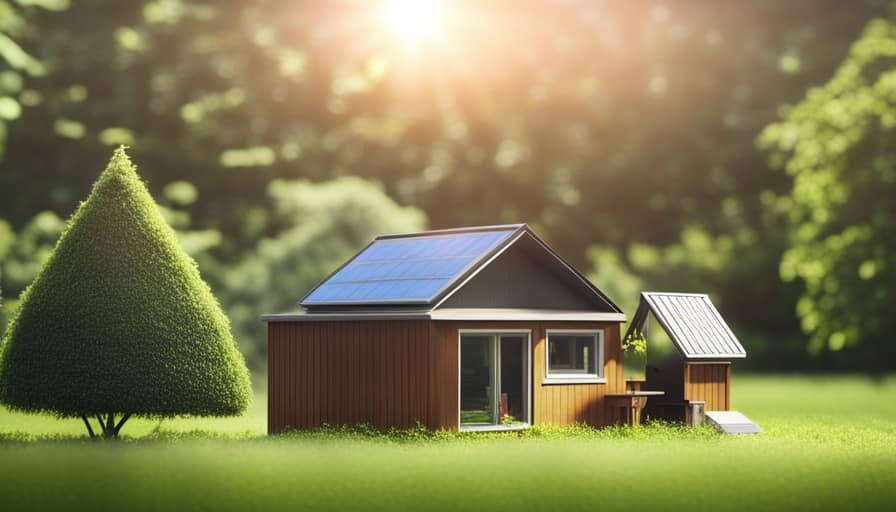
Utilizing Social Media and Online Communities
One can utilize social media and online communities to connect with fellow tiny house enthusiasts and discover potential listings for tiny houses for sale. Joining local groups on platforms like Facebook or Reddit can provide a wealth of information and resources. These groups often have members who are actively involved in the tiny house community and can offer valuable insights and recommendations. Engaging with these communities allows you to tap into a network of individuals who share your passion for tiny living and can guide you towards finding the perfect tiny house for sale.
Don’t hesitate to ask for recommendations within these groups, as members are usually more than willing to share their experiences and knowledge. By leveraging the power of social media and online communities, you can greatly increase your chances of finding the ideal tiny house for sale.
Now that we’ve explored the benefits of utilizing social media and online communities, let’s delve into the next step of the process – attending tiny house workshops and events.
Attending Tiny House Workshops and Events
To expand your knowledge and network in the world of tiny houses, consider attending workshops and events that focus on this unique lifestyle. These gatherings provide valuable opportunities to learn from experts, connect with like-minded individuals, and gain insight into the latest trends and innovations in the tiny house community. Here are three reasons why attending these workshops and events is beneficial:

-
Education: Workshops and events offer a wealth of information on various topics, including tiny house financing options. You can learn about different financing methods, such as loans, grants, and crowdfunding, to help make your tiny house dream a reality.
-
Networking: Meeting fellow enthusiasts and professionals in the industry is a great way to expand your network. You can exchange ideas, share experiences, and potentially find partners or mentors who can guide you through the process of building a tiny house on a foundation.
-
Inspiration: By attending workshops and events, you’ll be exposed to a wide range of tiny house designs and styles. This exposure can inspire you to think creatively and find innovative solutions for your own tiny house project.
Considering Alternative Options for Tiny House Living
I’ve explored various tiny house options, but my favorite alternative is living in a converted shipping container. Not only are shipping containers affordable and readily available, but they also provide a unique and eco-friendly living space.

One of the best aspects of living in a converted shipping container is the opportunity to join tiny house communities. These communities are designed to foster a sense of connection and support among residents, creating a tight-knit community where everyone looks out for each other.
Additionally, renting options for converted shipping containers are becoming more popular, allowing individuals to experience the benefits of tiny house living without the commitment of purchasing a property. This flexibility is perfect for those who want to try out the lifestyle before fully committing.
Frequently Asked Questions
Are There Any Specific Regulations or Zoning Requirements for Placing a Tiny House on a Property?
Regulations and zoning requirements vary depending on the location. Before placing a tiny house on a property, it is important to research and comply with local laws. Consulting with a real estate professional can provide guidance in navigating these regulations.
What Are Some Common Challenges or Considerations When It Comes to Financing a Tiny House?
When it comes to financing a tiny house, there are several challenges to consider. Affordability is a major concern, as well as finding lenders who understand the unique nature of tiny homes.
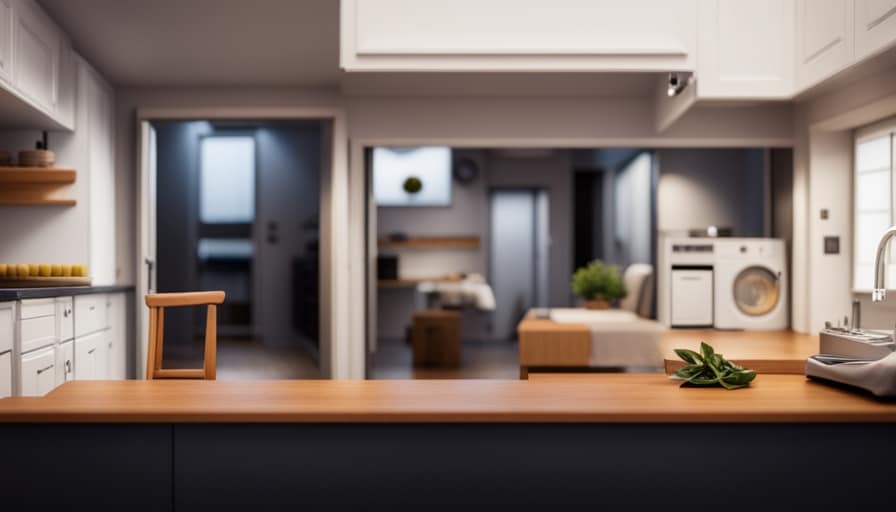
Can I Customize or Personalize a Pre-Built Tiny House From a Builder?
Yes, you can customize or personalize a pre-built tiny house from a builder. It allows you to tailor the design and features to your preferences, making it a unique and personalized space.
Are There Any Specific Insurance Considerations for Owning a Tiny House?
Insurance coverage for tiny houses requires considering their unique features and potential risks. It’s important to research insurance providers who specialize in tiny house coverage to ensure you have the right protection for your investment.
How Do I Navigate the Process of Finding Land or a Community to Park My Tiny House In?
Finding land or a community to park my tiny house in can be challenging. Research online platforms, local real estate agents, and tiny house communities. Visit potential locations, ask questions, and consider factors like zoning regulations and amenities.
Conclusion
In conclusion, there are several ways to make finding a tiny house for sale for adults easier. These include exploring online listings and websites, connecting with builders and companies, utilizing social media and online communities, and attending workshops and events.

One effective method is to search for tiny houses for sale through online listings and websites. There are dedicated platforms that specialize in listing tiny houses, making it convenient to browse through various options and compare prices and features.
Another option is to connect directly with builders and companies that specialize in constructing and selling tiny houses. Many builders have websites where they showcase their designs and provide information on how to purchase or customize a tiny house according to specific needs and preferences.
Utilizing social media and online communities can also be helpful in finding a tiny house for sale. There are groups and pages dedicated to tiny house living where individuals can connect with others who are selling or buying tiny houses. These platforms provide a space for sharing information, asking questions, and even finding potential sellers or buyers.
Attending workshops and events related to tiny house living is another valuable way to find a tiny house for sale. These events often feature displays of different tiny house designs and provide an opportunity to meet builders, sellers, and other individuals who are passionate about tiny house living.

It’s interesting to note that the popularity of tiny house living is on the rise. According to a survey conducted by Tiny House Community, the number of adults opting for tiny house living has increased by 67% in the past five years. This statistic highlights the growing appeal and interest in this alternative lifestyle.
Overall, by utilizing online resources, connecting with builders and companies, engaging with social media and online communities, and attending workshops and events, adults can make the search for a tiny house for sale much easier.
I’m Theodore, and I love tiny houses. In fact, I’m the author of Tiny House 43, a book about tiny houses that are also tree houses. I think they’re magical places where imaginations can run wild and adventures are just waiting to happen.
While tree houses are often associated with childhood, they can be the perfect adult retreat. They offer a cozy space to relax and unwind, surrounded by nature. And since they’re typically built on stilts or raised platforms, they offer stunning views that traditional homes simply can’t match.
If you’re looking for a unique and romantic getaway, a tree house tiny house might just be the perfect option.
-

 Beginners Guides1 week ago
Beginners Guides1 week agoHow To Buy A Tesla Tiny House
-

 Energy Efficiency1 month ago
Energy Efficiency1 month agoBest Tiny Homes For Cold Climates
-

 Beginners Guides6 days ago
Beginners Guides6 days agoTiny House Nation Where Are They Now Stephanie
-

 Tiny House Resources (e.g., legalities, cost, insurance, FAQs)2 months ago
Tiny House Resources (e.g., legalities, cost, insurance, FAQs)2 months agoDo Tiny Homes Need Planning Permission?
-

 Beginners Guides2 weeks ago
Beginners Guides2 weeks agoFrom The Show Tiny House Nation How Many Keep Their Tiny House?
-

 Beginners Guides2 months ago
Beginners Guides2 months agoUsing a Climbing Net For Treehouse Construction
-

 Beginners Guides2 months ago
Beginners Guides2 months agoHow to Build a Treehouse Without Drilling Into the Tree
-

 Beginners Guides3 weeks ago
Beginners Guides3 weeks agoTiny House Nation Who Pays For The Houses













